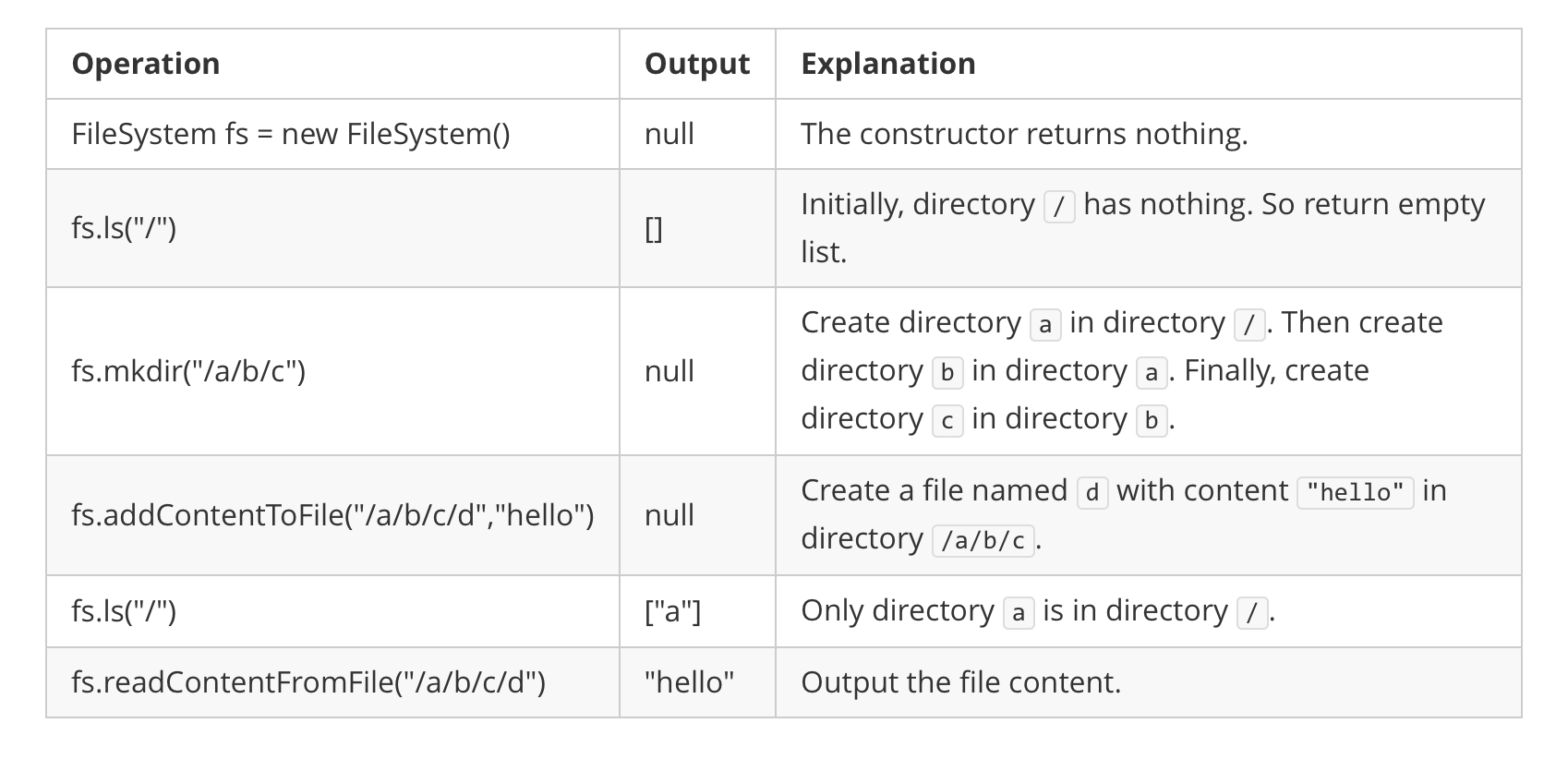[LeetCode] Design In-Memory File System 设计内存文件系统
Design an in-memory file system to simulate the following functions:
ls: Given a path in string format. If it is a file path, return a list that only contains this file's name. If it is a directory path, return the list of file and directory names in this directory. Your output (file and directory names together) should in lexicographic order.
mkdir: Given a directory path that does not exist, you should make a new directory according to the path. If the middle directories in the path don't exist either, you should create them as well. This function has void return type.
addContentToFile: Given a file path and file content in string format. If the file doesn't exist, you need to create that file containing given content. If the file already exists, you need to append given content to original content. This function has void return type.
readContentFromFile: Given a file path, return its content in string format.
Example:
Input: ["FileSystem","ls","mkdir","addContentToFile","ls","readContentFromFile"] [[],["/"],["/a/b/c"],["/a/b/c/d","hello"],["/"],["/a/b/c/d"]] Output: [null,[],null,null,["a"],"hello"] Explanation:

Note:
- You can assume all file or directory paths are absolute paths which begin with
/and do not end with/except that the path is just"/". - You can assume that all operations will be passed valid parameters and users will not attempt to retrieve file content or list a directory or file that does not exist.
- You can assume that all directory names and file names only contain lower-case letters, and same names won't exist in the same directory.
这道题让我们设计一个内存文件系统,实现显示当前文件,创建文件,添加内容到文件,读取文件内容等功能,感觉像是模拟一个terminal的一些命令。这道题比较tricky的地方是ls这个命令,题目中的例子其实不能很好的展示出ls的要求,其对文件和文件夹的处理方式是不同的。由于这里面的文件没有后缀,所以最后一个字符串有可能是文件,也有可能是文件夹。比如a/b/c,那么最后的c有可能是文件夹,也有可能好是文件,如果c是文件夹的话,ls命令要输出文件夹c中的所有文件和文件夹,而当c是文件的话,只需要输出文件c即可。另外需要注意的是在创建文件夹的时候,路径上没有的文件夹都要创建出来,还有就是在给文件添加内容时,路径中没有的文件夹都要创建出来。论坛上这道题的高票解法都新建了一个自定义类,但是博主一般不喜欢用自定义类来解题,而且感觉那些使用了自定义类的解法并没有更简洁易懂,所以这里博主就不创建自定义类了,而是使用两个哈希表来做,其中dirs建立了路径和其对应的包含所有文件和文件夹的集合之间的映射,files建立了文件的路径跟其内容之间的映射。
最开始时将根目录"/"放入dirs中,然后看ls的实现方法,如果该路径存在于files中,说明最后一个字符串是文件,那么我们将文件名取出来返回即可,如果不存在,说明最后一个字符串是文件夹,那么我们到dirs中取出该文件夹内所有的东西返回即可。再来看mkdir函数,我们的处理方法就是根据"/"来分隔分隔字符串,如果是Java,那么直接用String自带的split函数就好了,但是C++没有Java那么多自带函数,所以只能借助字符串流类来处理,处理方法就是将每一层的路径分离出来,然后将该层的文件或者文件夹加入对应的集合中,注意的地方就是处理根目录时,要先加上"/",其他情况都是后加。下面来看addContentToFile函数,首先分离出路径和文件名,如果路径为空,说明是根目录,需要加上"/",然后看这个路径是否已经在dirs中存在,如果不存在,调用mkdir来创建该路径,然后把文件加入该路径对应的集合中,再把内容加入该文件路径的映射中。最后的读取文件内容就相当简单了,直接在files中返回即可,参见代码如下:
class FileSystem { public: FileSystem() { dirs["/"]; } vector<string> ls(string path) { if (files.count(path)) { int idx = path.find_last_of('/'); return {path.substr(idx + 1)}; } auto t = dirs[path]; return vector<string>(t.begin(), t.end()); } void mkdir(string path) { istringstream is(path); string t = "", dir = ""; while (getline(is, t, '/')) { if (t.empty()) continue; if (dir.empty()) dir += "/"; dirs[dir].insert(t); if (dir.size() > 1) dir += "/"; dir += t; } } void addContentToFile(string filePath, string content) { int idx = filePath.find_last_of('/'); string dir = filePath.substr(0, idx); string file = filePath.substr(idx + 1); if (dir.empty()) dir = "/"; if (!dirs.count(dir)) mkdir(dir); dirs[dir].insert(file); files[filePath].append(content); } string readContentFromFile(string filePath) { return files[filePath]; } private: unordered_map<string, set<string>> dirs; unordered_map<string, string> files; };
类似题目:
参考资料:
https://discuss.leetcode.com/topic/90250/c-fast-no-user-defined-types-needed










【推荐】还在用 ECharts 开发大屏?试试这款永久免费的开源 BI 工具!
【推荐】国内首个AI IDE,深度理解中文开发场景,立即下载体验Trae
【推荐】编程新体验,更懂你的AI,立即体验豆包MarsCode编程助手
【推荐】轻量又高性能的 SSH 工具 IShell:AI 加持,快人一步